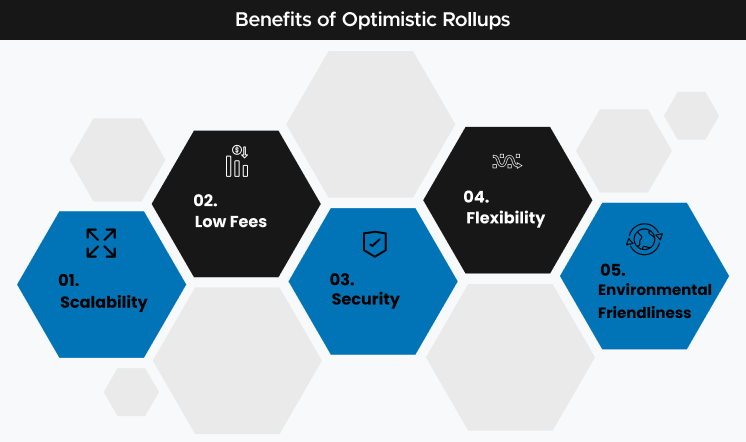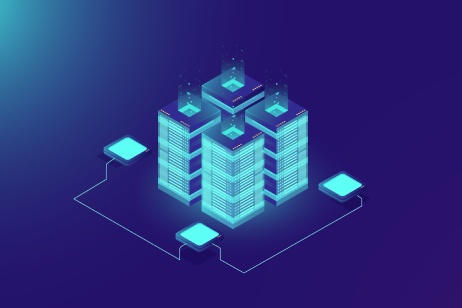-
The popularity of the Ethereum blockchain application development has attracted many crypto users to the blockchain network. Consequently, the network has become slow and expensive. Eventually, the network emerged with layer-2 (L2) solutions, such as rollups that work by processing transactions on another faster blockchain. Subsequently, they transport the data to the parent blockchain. Users get the benefits of security as well as speed. Mainly, there are two types of rollups, zero-knowledge (ZK) and optimistic rollups. In this article, we will talk about the latter.
Optimistic Rollups
An optimistic rollup is a type of L2 scaling solution that enhances latency and throughput on Ethereum's base layer. It conducts off-chain transactions, reducing network congestion and improving efficiency. Optimistic rollups assume all the transactions are valid within a rollup. They give the network a week to contest fraudulent transactions within a week. They show transaction results on the mainnet, which then provides them security. The mainnet uses fraud proofs to make sure verification of Ethereum transactions. An optimistic rollup has three main components - a smart contract on Ethereum, a sequencer, and a set of validators. The smart contract manages the L2 and Ethereum interaction. The sequencer transactions and generates roll-up blocks. Lastly, validators monitor the L2 chain and give fraud proof to the smart contract in case of invalid transactions. Suggested Read | Comprehending ZK Rollups | Layer 2 Scaling Solutions
The Need for Optimistic Rollups
The growth of the Ethereum network led to an increase in the number of transactions on the blockchain, resulting in network congestion. Consequently, the transaction speed became slow, and the network charged high gas fees. Users find it difficult to use dApps (decentralized applications) on the Ethereum network. Additionally, network congestion restricts the growth of dApp platforms requiring high transaction throughput to offer liquidity to the market. So, the Ethereum network used optimistic rollups and other types of rollups to resolve the scalability issues. Also, Visit | Layer 2 Blockchain Scaling Solutions | Resolving Scalability Issues
Types of Optimistic Rollups
Optimistic rollups do not represent a single protocol; instead, they belong to a class of protocols that share common characteristics and design principles:
Execution Model
The Ethereum Virtual Machine (EVM) serves as the base layer for EVM-compliant rollups. It enables rollups to execute any Ethereum-based smart contract without modification.
Data Availability Solution
Decentralized data availability solutions leverage a peer-to-peer or decentralized storage network, such as IPFS. They store and share full-block data in a distributed manner. However, the storage and provision of full-block data is the responsibility of a single server or a reliable third party in centralized data availability systems. Decentralized solutions come with higher prices and additional complexity, but they also provide improved security and resistance to censorship. Centralized solutions, on the other hand, rely on trust and are more vulnerable to flaws while being more inexpensive and easier to execute.
Also, Explore | How ZK-Rollups are Streamlining Crypto Banking in 2024
Fraud Proof Mechanism
In interactive fraud-proof mechanisms, the sequencer and validators engage in a challenge-response game to validate a block's authenticity. On the other hand, non-interactive fraud-proof mechanisms use cryptographic proofs or witnesses to verify a block's validity without requiring any interaction. Interactive fraud-proof mechanisms offer greater flexibility and generality in their application. However, they tend to be more costly and time-consuming to implement. Non-interactive mechanisms, in contrast, are more efficient and faster in verifying blocks. However, they are often more restrictive and specialized in their usage. Check It Out | zkEVM | Boosting Ethereum's Scalability
Benefits of Optimistic Rollups
The following are the benefits of optimistic rollups:

Scalability
Optimistic rollups execute most of the computation off-chain, reducing the on-chain processing requirements. They deliver periodic batch updates to the main Ethereum network. It significantly improves scalability. They can process a large number of transactions and smart contracts more efficiently, reducing congestion and lowering transaction fees.
Low Fees
Optimistic rollups can significantly reduce transaction costs compared to executing transactions directly on the Ethereum mainnet. By aggregating multiple transactions into batches, users can benefit from cost savings while enjoying the security of the underlying Ethereum network.
Security
Optimistic rollups are designed to be compatible with the Ethereum Virtual Machine (EVM) and can execute existing Ethereum smart contracts without modifications. This interoperability allows developers and users to leverage the existing Ethereum ecosystem and tools.
Flexibility
With the adoption of Optimistic rollups, developers gain enhanced flexibility in designing and deploying novel decentralized applications (dApps) on the Ethereum network. It empowers them to introduce innovative solutions and explore new possibilities within the Ethereum ecosystem.
Environmental Friendliness
Optimistic rollups provide a greener alternative to traditional on-chain transactions by minimizing the number of transactions that take place directly on the Ethereum mainnet. This reduction in on-chain transactions leads to a decrease in energy consumption associated with the mining and validation processes. As a result, optimistic rollups contribute to a more environmentally friendly approach to conducting transactions on the Ethereum network. Explore More | Deciphering Ethereum Shanghai, Shapella Upgrade
Conclusion
In conclusion, optimistic rollups provide scalability, cost-effectiveness, and compatibility for Ethereum. They enable innovative dApp development while reducing fees and congestion. With fraud proofs, they ensure transaction integrity and contribute to a more sustainable blockchain ecosystem. If you are interested in utilizing optimistic rollups to its full potential, then connect with our developers today.

Our Offices
INDIA
Emaar Digital Greens, Sector 61,
Gurugram, Haryana
122011.
Welldone Tech Park,
Sector 48, Sohna road,
Gurugram, Haryana
122018.















